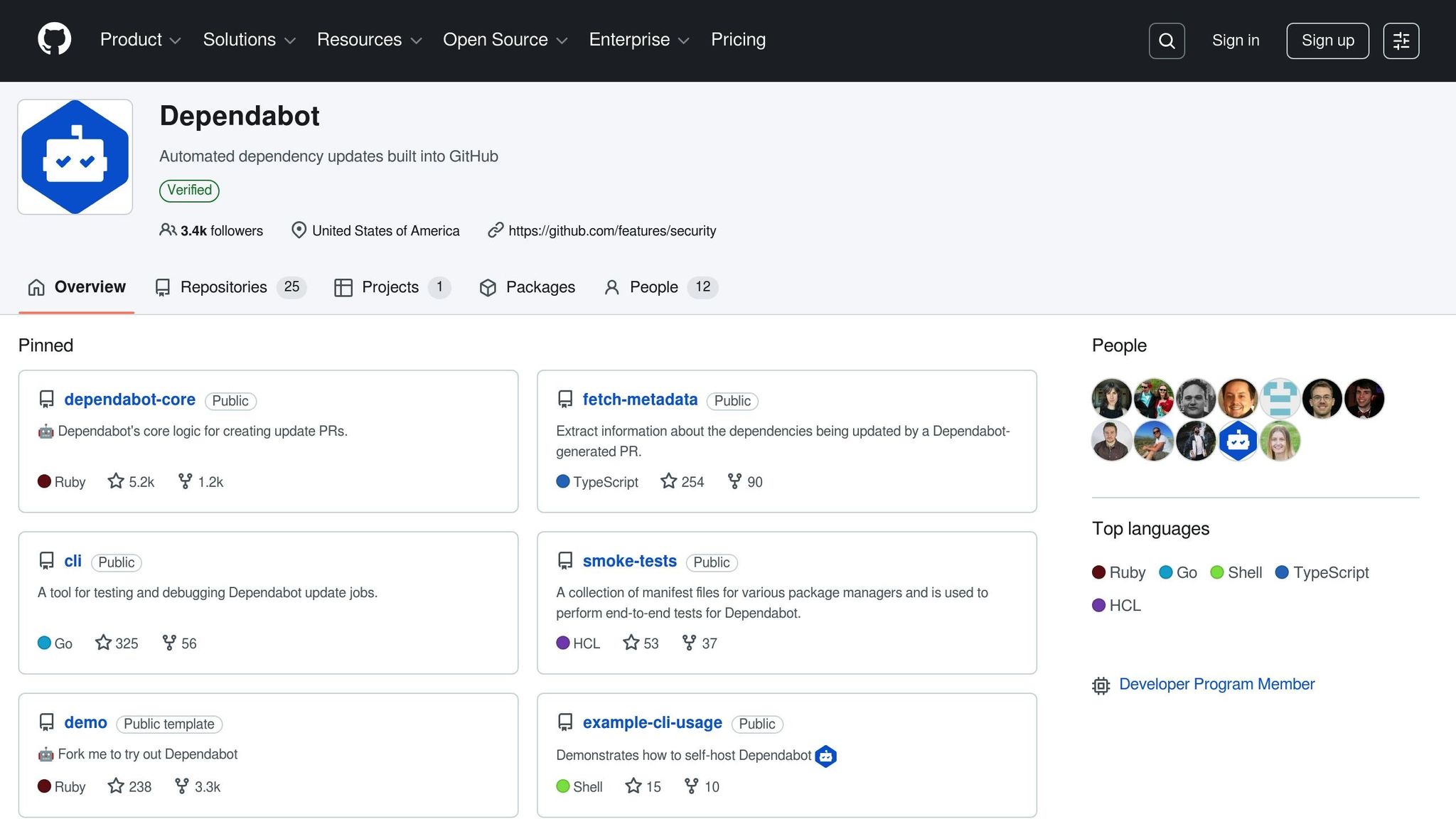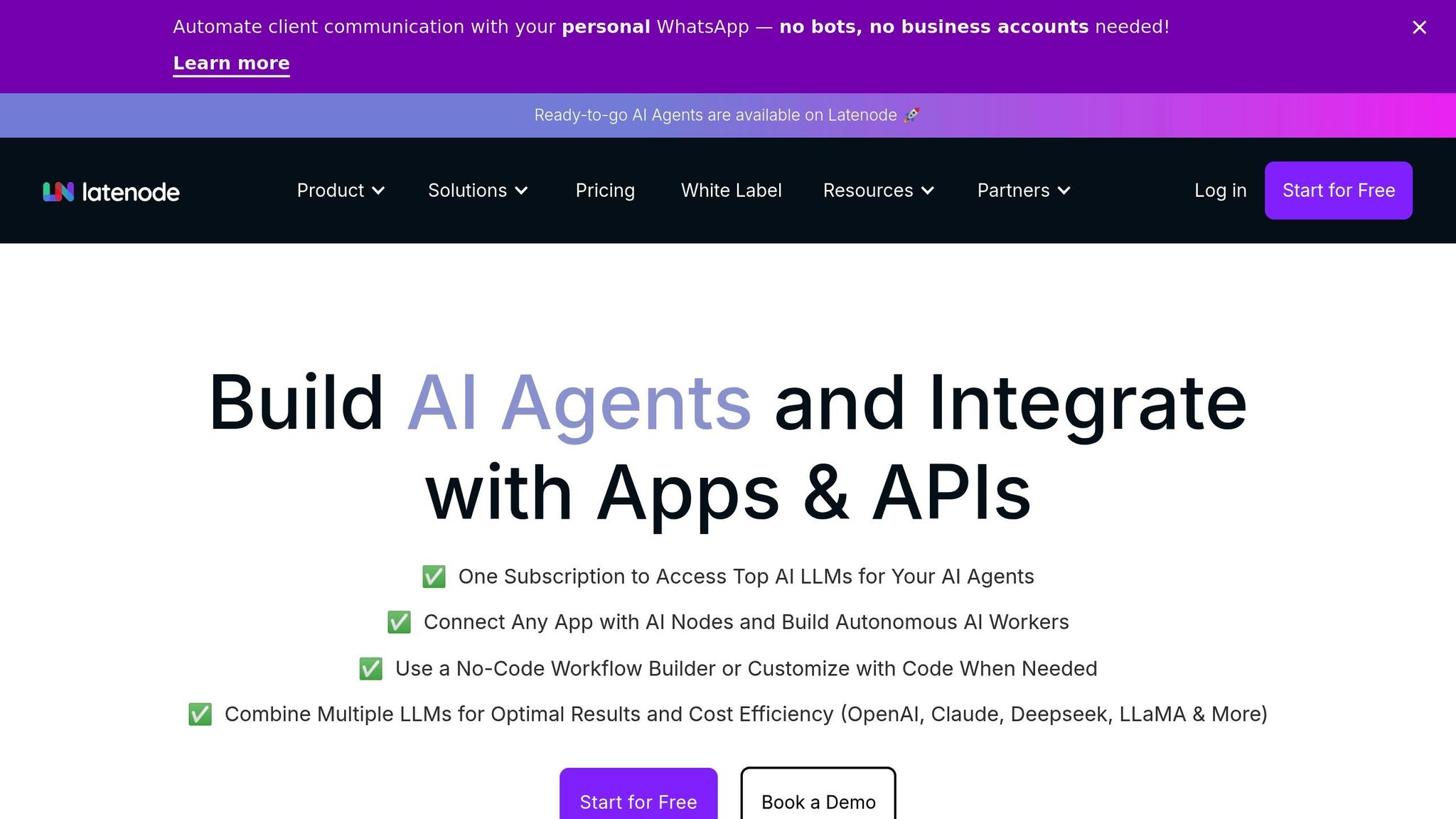


Automating NPM security updates is one of the fastest ways to minimize risks in your codebase. With over a million packages in the npm registry, keeping dependencies safe and current can feel overwhelming. Tools like npm audit, Dependabot, and platforms such as Latenode simplify this process, ensuring vulnerabilities are addressed quickly and efficiently. For example, Latenode allows you to visually design workflows that automatically scan, update, and notify teams about security issues - all without writing extensive code. By integrating these tools into your CI/CD pipeline, you can protect your projects while saving time and effort.
Automating dependency updates is essential for maintaining secure and stable projects. By combining npm's security tools with GitHub's automation features, you can create a reliable system to monitor and resolve vulnerabilities efficiently.

The npm audit command is an essential tool for identifying vulnerabilities in your project's dependencies. Introduced in npm@6, this utility scans your dependencies against known vulnerability databases and provides detailed reports. While npm audit runs automatically during npm install, running it manually gives you greater control over the process.
When executed manually, npm audit examines all types of dependencies - direct, devDependencies, bundledDependencies, and optionalDependencies. If no vulnerabilities are found, the command exits with a zero code, making it highly suitable for CI/CD pipelines. You can customize its behavior with options like:
--audit-level to set a minimum severity threshold for vulnerabilities.--production to focus only on production dependencies.--json for machine-readable output.To complement npm audit, Dependabot automates the process of updating vulnerable dependencies. Dependabot creates pull requests whenever it detects issues, streamlining the update process. To set up Dependabot, add a .github/dependabot.yml file to your repository with a configuration like this:
| Configuration Key | Value | Purpose |
|---|---|---|
package-ecosystem |
"npm" | Specifies NPM as the package manager |
directory |
"/" | Points to the root directory containing the package.json file |
schedule.interval |
"daily", "weekly", or "monthly" | Determines how often updates are checked |
Additionally, tools like audit-ci can enhance your workflow by failing builds if vulnerabilities exceed predefined thresholds, ensuring insecure code never reaches production. Together, npm audit, Dependabot, and tools like audit-ci provide a comprehensive approach to vulnerability management.
Once you’ve automated vulnerability detection, managing the package-lock.json file becomes critical for maintaining stable and secure dependency versions. This file locks exact versions of every dependency in your project, ensuring consistency across all environments and preventing unexpected updates that could introduce vulnerabilities or break functionality.
Avoid manually editing the package-lock.json file. Instead, let npm handle updates automatically when dependencies change. Always commit both package.json and package-lock.json together to version control, as they work in tandem to ensure reproducibility.
In CI/CD pipelines, use npm ci rather than npm install for installing dependencies. The npm ci command strictly adheres to the lock file, ensuring exact versions are installed and reducing the risk of version drift between development and production. It also runs faster, making it an efficient choice for automated environments.
For ongoing maintenance, regularly run npm outdated to identify packages with available updates. Use npm update to refresh dependencies within their defined version ranges. If vulnerabilities arise, npm audit fix can automatically update the lock file with patched versions.
After automating dependency updates, securing your CI/CD pipeline becomes essential to block vulnerabilities from sneaking in. A compromised pipeline can lead to code injection, data breaches, or unauthorized access. By embedding security monitoring and automated dependency updates into your continuous integration and deployment workflows, you turn your pipeline into a proactive defense mechanism.
Every stage of your CI/CD process - source, build, test, and deploy - should include dedicated security measures. Configure your CI/CD systems to trigger security scans right after code commits using webhooks or polling. Incorporating automated scans during builds transforms potential risks into actionable alerts.
For example, running npm audit automatically in the pre-deployment phase with the --json option allows seamless integration with monitoring tools. This ensures a thorough scan of your dependency tree before the code moves forward in the pipeline.
Tools like Snyk provide advanced scanning capabilities that integrate smoothly into CI/CD workflows. Acting as a gatekeeper, Snyk can block deployments if vulnerabilities exceed predefined thresholds, ensuring continuous security checks. By setting severity filters, you can configure your pipeline to fail builds only for high or critical issues. Additionally, combining these scans with tools like SonarQube or SonarCloud offers deeper insights into code quality, security risks, and technical debt. During development, integrating ESLint with plugins like eslint-plugin-security and eslint-plugin-node can help identify potential issues early on.
Automated scans are just one piece of the puzzle. A secure CI/CD pipeline demands robust practices to ensure comprehensive protection. Start with strict secret management: tools like HashiCorp Vault or AWS Secrets Manager can securely manage API keys, database credentials, and deployment tokens - avoiding the risks of hardcoding sensitive data in configurations.
Role-Based Access Control (RBAC) is another critical layer. Define roles clearly and follow a least privilege approach, granting access to only the resources necessary for each pipeline stage. Regularly review access permissions to ensure they remain appropriate.
Pre-commit hooks and secret scanning tools can prevent sensitive information from entering your codebase. Organizing repositories with clear security boundaries and implementing validation pipelines using GitOps practices helps maintain an audit trail and prevents unauthorized changes.
To keep your team informed, ensure vulnerability alerts are delivered in real time. Integrate notifications into channels like Slack, Microsoft Teams, or email, so any emerging issues are addressed promptly.
For teams looking to streamline security workflows, Latenode offers powerful automation capabilities. For instance, you can create a custom workflow that connects GitHub Webhooks with npm audit, sends Slack alerts, and generates Jira tickets, forming a comprehensive security response system.
Finally, regular maintenance is key to keeping your pipeline secure. Use Snyk's continuous monitoring feature to detect new vulnerabilities in dependencies post-deployment. Additionally, ensure that all tools, plugins, and dependencies are updated frequently with the latest security patches to maintain their effectiveness.

Latenode takes NPM security automation to the next level by providing a flexible, visual platform for building workflows. While traditional CI/CD tools cover basic vulnerability scanning, Latenode allows users to design detailed automation processes that link vulnerability detection, notifications, and tracking - all in one place.
Latenode simplifies the creation of NPM security workflows by leveraging its AI Code Copilot, which can generate JavaScript functions that integrate directly with NPM's audit API. With access to over 1 million NPM packages, users can incorporate security tools like audit-ci or better-npm-audit without complicated setups or additional dependencies.
Workflows typically start with webhook triggers, which activate whenever a new commit is pushed to your GitHub repository. Once triggered, a custom JavaScript node runs the npm audit --json command, processes the vulnerability data, and stores the results in Latenode's built-in database. This eliminates the need for external storage solutions while providing a searchable audit trail for tracking vulnerabilities over time.
The platform's visual workflow builder makes it easy to create conditional logic based on vulnerability severity. For instance, critical vulnerabilities can trigger immediate Slack alerts and Jira tickets, while less severe issues can be grouped into weekly reports. Thanks to its drag-and-drop interface, even users with limited coding experience can design and manage these workflows effectively.
As Francisco de Paula S., a Web Developer, shares: "The AI JavaScript code generator node is a lifesaver. If you hit a point where a tool or node you need isn’t available, the AI makes it easy to create custom solutions."
Latenode also supports headless browser automation, which can automatically check for NPM package advisories and download updated documentation. This capability ensures that your workflows extend beyond detection, seamlessly integrating with earlier CI/CD checks to provide a complete security loop.
Effective NPM security automation doesn’t stop at detecting vulnerabilities - it requires intelligent monitoring and alerting systems to keep teams informed without overwhelming them. Latenode’s built-in database acts as a centralized hub for tracking vulnerabilities, storing historical data to help teams analyze trends and identify recurring issues across dependencies.
By integrating with 200+ AI models through platforms like OpenAI and Claude, Latenode enables advanced alert filtering and prioritization. For example, workflows can use natural language processing to analyze vulnerability descriptions and assess actual risk levels based on how specific dependencies are used in your application. This reduces false positives and ensures developers focus on the most critical issues.
Charles S., a Small-Business Founder, highlights: "My favorite things about Latenode are the user interface and the code editor. Being able to write 'some' of your own code makes a huge difference when building automations quickly."
Latenode’s real-time monitoring capabilities also include tracking dependency updates. Features like execution history and scenario re-runs allow teams to debug and refine workflows as security needs evolve, ensuring long-term effectiveness.
For organizations managing multiple projects, Latenode’s pricing model - based on execution time rather than per-action costs - makes it a budget-friendly option for comprehensive monitoring.
Sophia E., an Automation Specialist, notes: "Latenode is a cost-effective, powerful tool designed for rapid automation. It's easy to use, even for beginners, thanks to its simple and intuitive interface."
Additionally, Latenode’s webhook responses enable two-way communication with external security tools. This means workflows can both receive vulnerability notifications and send remediation updates back to your existing dashboards or ticketing systems. By integrating seamlessly with your current security setup, Latenode enhances your automation capabilities without disrupting established processes.
Establishing a robust NPM security automation strategy requires more than just initial setup - it demands ongoing maintenance and strict access controls. With approximately 76% of Node.js projects relying on vulnerable packages, regular upkeep is essential to safeguard your applications. Even the most advanced automation systems need consistent attention to adapt to emerging vulnerabilities and evolving development practices.
Keeping your projects secure starts with routine scanning and updates. Striking the right balance is crucial - overly frequent scans can generate unnecessary noise, while infrequent checks leave your projects vulnerable.
A practical starting point is running npm outdated weekly to identify packages with newer versions. Pair this with npm audit during every build to catch newly disclosed vulnerabilities. For a more comprehensive analysis, tools like snyk test can uncover additional risks, complementing npm's built-in security features.
Before applying major updates, always review the changelogs to avoid compatibility issues. For targeted updates, use npm install <package_name>@<version_number> for specific versions or npm update <package_name> to stay within the version range defined in your package.json file.
Latenode simplifies this process by enabling automated workflows that schedule regular dependency scans and generate detailed reports. This automation ensures consistent monitoring without requiring manual intervention while maintaining an audit trail for accountability.
Another critical step is removing unused dependencies. Regularly auditing your package.json file helps identify and eliminate unnecessary packages, reducing security risks and cutting down on maintenance efforts. Additionally, reviewing your package-lock.json file ensures consistent dependency versions across all environments, minimizing unexpected issues.
Once regular scans are in place, securing access to these workflows becomes a priority. Strong access controls enhance the effectiveness of your CI/CD pipelines and automation measures.
Implementing Role-Based Access Control (RBAC) and multi-factor authentication (MFA) is essential for safeguarding your workflows. Grant access strictly based on necessity - developers might only need read access to vulnerability reports, while security teams manage scanning schedules and alert configurations. This principle of least privilege minimizes exposure to potential breaches.
Automated workflows often require elevated privileges to update dependencies or modify repositories. Adding extra layers of authentication makes it significantly harder for attackers to exploit these workflows.
Centralized access management simplifies privilege tracking and policy updates, especially when managing multiple teams and projects. Administrators can quickly assess who has access to specific workflows and adjust permissions as needed.
"Access control permits access for authorized network users and excludes users without the right credentials or access privileges." - NordLayer.com
Automating off-boarding processes ensures that access is immediately revoked when employees leave, reducing the risk of unauthorized activity.
Latenode offers robust access control features that integrate seamlessly with existing authentication systems. Its granular permission settings and audit logging capabilities provide a clear record of who modified workflows and when, aiding in regulatory compliance.
Regularly auditing user access patterns can reveal unusual behavior or outdated permissions. High-privilege accounts, in particular, should undergo more frequent reviews - quarterly at a minimum. Adding context-based controls, such as monitoring access based on location, device type, or time, introduces additional security layers for sensitive operations.
"Well-designed access systems prevent unauthorized access to sensitive data while enabling legitimate users to work efficiently." - NordLayer.com
Monitoring access patterns and setting up alerts for unusual behavior, like modifications outside typical business hours, allows for swift responses to potential security threats. Proactive measures like these strengthen your NPM security automation framework, ensuring it remains effective and resilient.
Automating NPM security updates shifts the focus of vulnerability management from reactive fixes to proactive prevention. With automation in place, development teams can stay ahead of the ever-changing threat landscape by addressing vulnerabilities swiftly and efficiently.
Recent statistics highlight the urgency: in 2024, 77% of organizations reported at least one security incident tied to vulnerable dependencies. The npm registry continues to receive thousands of vulnerability reports each year, most of which are addressed through timely patches. However, manually keeping up with these updates across multiple projects is nearly impossible, especially for large development teams.
Latenode simplifies and centralizes this process, enabling teams to automate their security workflows without the need for complex coding. Its drag-and-drop interface allows users to create workflows effortlessly, while its native JavaScript support provides flexibility for advanced customization. For example, a Latenode workflow could schedule nightly npm audit scans, automatically update dependencies when vulnerabilities are detected, run tests to ensure application stability, and notify developers when manual input is required - all in one seamless process.
This integrated approach replaces the inefficiencies of fragmented security tools, creating a cohesive system that enhances security automation. By unifying these processes, teams can address vulnerabilities faster and more effectively.
Adopting such strategies transforms how teams handle security. Regular scanning, automated updates, and thorough testing ensure a balance between robust protection and practical implementation. Automation not only reduces the risk of security incidents but also frees developers to focus on building new features instead of managing patches.
Take the first step toward automated NPM security workflows today. By doing so, you’ll minimize vulnerability risks, streamline your development process, and turn security from a reactive challenge into a proactive advantage.
Latenode simplifies the task of automating NPM security updates by combining AI-driven workflows with a user-friendly builder that offers both visual and code-based customization. This approach allows you to easily embed security checks into your CI/CD pipeline while retaining the flexibility to handle more advanced scenarios.
With Latenode, you can automate essential processes such as dependency scanning, vulnerability detection, and update deployment - all without the need for time-consuming manual configurations. Thanks to its support for custom code and integration with over 300 apps, it seamlessly connects to your existing tools, enabling teams to enhance security and efficiency with minimal effort.
To keep your CI/CD pipeline secure and up-to-date with NPM security updates, start by integrating tools like Dependabot or Renovate. These tools are designed to detect outdated or vulnerable dependencies and can automatically generate pull requests to update them, saving you time and ensuring critical patches are applied promptly.
For an extra layer of security, incorporate static application security testing (SAST) and software composition analysis (SCA) into your pipeline. These methods help uncover vulnerabilities in both your code and its dependencies. Additionally, make it a habit to regularly review logs and alerts to catch any unusual activity early. These practices align with modern DevSecOps principles, helping you maintain a secure and efficient pipeline with minimal manual intervention.
If you’re seeking a flexible way to build custom automation workflows, Latenode offers a low-code platform tailored to advanced integrations and automations, including CI/CD processes. Its visual workflow builder and coding capabilities make it easy to design and scale solutions that fit your specific requirements.
To ensure your team stays informed without being overwhelmed by excessive alerts, it’s essential to prioritize notifications based on severity levels and automate the handling of routine alerts. Establish clear criteria for what qualifies as a critical issue, ensuring that only high-priority alerts reach your team.
Using specific communication channels, like dedicated Slack groups or targeted email lists, can help streamline the flow of information. Regularly revisiting and refining your alert policies keeps the focus on addressing the most urgent vulnerabilities. Additionally, coordinating with leadership on alert strategies and temporarily muting non-essential notifications can enhance productivity and minimize unnecessary interruptions.



